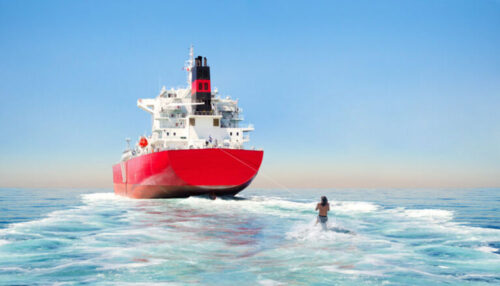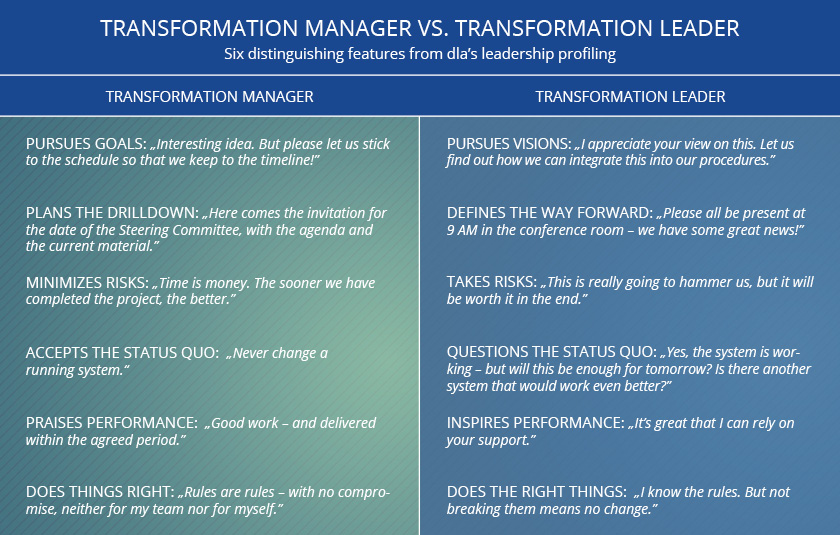
The management styles and cultures that motivate employees to go that extra mile toward a company’s success is discussed in the second part of the interview.
dla: Mr Thelen, the appeal Dieter Zetsche made to the automotive industry before he left Daimler was clear: “If we don’t change, we are finished.” In other sectors as well the pressure to change is growing – in some faster than in others. What are the drivers at work here?
Marco Thelen: Generally, companies whose traditional value chains suddenly break up or threaten to disintegrate are the ones most affected. Take the topic of innovative ability, for instance: R&D teams who have been working in complete isolation for years are required to collaborate via crowd source platforms with partners, customers, or even with competitors, and not just any time in the future, but suddenly next year. Changes of this kind are already challenging enough in themselves.
“The good news about transformation pressure: there is no end in sight.”
In my view, dealing with complexity, hugely exacerbated by digitalization, is the greatest source of stress and strain across all disciplines. Added to this is the speed at which markets change today, meaning that one needs to come up with new products and services and launch them at a punishing rate. Especially companies with traditional structures often find it difficult to keep up here. On the one hand, they have to deeply diversify their product and service portfolios, all the while ensuring that they take their own organizations that have evolved over years forward and restructure them. This is a gargantuan stress test. But the good news is: there is no end in sight.
dla: Why is that good news?
Marco Thelen: Because it can strengthen an organization if it understands the principle of the permanent ability to change and begins to live. This change starts when managers and employees understand that the storm will not pass over – but will take the organization to new shores.
“Change begins when employees understand that the storm will carry the organization to new shores.”
This is, however, easier said than done if the buildup of pressure is combined with the feeling of being overchallenged and of not being able to withstand this pressure. A situation such as this can only be counteracted by consistently enabling one’s own employees. In essence: switching from directive management to people management, which will give employees their own space to make decisions while preparing and them for their tasks and involving them. By contrast, directive management, being afraid of change and sanctioning mistakes, creates an extremely dangerous environment for employees, which will ultimately lead to a denial of complexity: “We will continue in the same vein as before.” Unless they are shown the way out.
dla: Where do good managers begin in initiating this change?
Marco Thelen: With themselves. A manager whose style has been directive for decades is not going to change his or her behavioral patterns after three workshops or leadership training. For instance, many managers are hugely challenged by letting go of micromanagement and gradually crediting employees with more trust. This is naturally especially difficult for the generation of managers who have been “socialized” in quite the opposite direction all of their working lives.
Moreover, a manager must be able to identify and communicate the “lodestar” for the transformation road map. Employees need to be clearly informed about the direction things are now going in – and the goal needs to be frequently recalibrated. This is no small matter in any form of organization. Managers of all generations have to battle with it, from start-ups right through to the large corporations.
dla: Mr Derakhchan, as a personnel advisor you support companies that are generally exposed to particularly strong pressure to change – do you share this opinion?
Marcel Derakhchan: Yes, but I would like to add: managing on a basis of greater trust does not mean relinquishing responsibility – not only at team level, but also across the entire organization. Take the example of a zero-defect culture: does the management team really endorse a corporate culture where employees may only raise their hands if they have the feeling that something is going in the wrong direction? Or is an approach of this kind still to be condoned going forward?
“Managing on the basis of trusting more does not mean relinquishing responsibility.”
“Diesel gate” and the Boeing disaster are both prime examples of the problematic attempt to find the way into the New World using methods from the Old. Criticism voiced from a company’s own ranks interferes with the attempt to keep pace with the market and meet shareholder expectations, which brings us back to the omnipresent transformation pressure. In this situation – here, I totally agree with Marco Thelen – “carrying on as before” is generally the worst option.
dla: At this point, how can a “zero-defect culture” manage a successful change?
Marco Thelen: We start with destroying illusions! Nowadays no company with global operations, whether DAX-listed or an SME, should be permitted to attribute its shortcomings to its western origins. But this is precisely what often happens.
Instead of focusing on the past, attention should be dedicated to the future: on creating flat hierarchies and minimizing power distance. It’s about getting an idea of how work essentially needs to be performed in the future: how, for instance, can stock be taken of organization’s existing talents and strengths? Should this focus on individual employees, in small team units, or interdisciplinary cooperation across departments?
dla: That sounds as if managers mainly need to manage talent …
Marco Thelen: No, that is not the case. A talent manager strengthens capabilities but does not need to know the long-term orientation of a team or an organization to perform this task. Being able to do both is a classic management paradigm. With flat hierarchies this is, however, no longer sufficient.
dla: And why?
Marco Thelen: Because goals may change, and not at yearly intervals, but on a monthly or even on a weekly basis. Managers are therefore frequently required to review and adjust the path the company, the department or the team is on. As already noted, a manager who has confidence in his or her employees is less concerned with control and micromanagement. The time this saves should be invested in developing a vision, communicating this vision, and then checking frequently where one stands with all employees in a larger context: what are the shared values of the employees? To what extent does this pay into the vision? Is the vision still the right one? Does the management team need to readjust the vision, or is it down to the employees to make adjustments to what they do?

dla: Recalibrate, review, communicate – how does all this fit in with the ideal TOP manager who can lift an organization to a new level all by himself?
Marcel Derakhchan: This idea of a manager in superhero mode is outdated. The challenges today are so complex that they can only be solved in the context of a team. A good comparison is team sport where you need a captain or a coach to give direction, but the championship can only be won together.
This coach should naturally possess the competencies that are appropriate in times of constant flux. For instance: a “transformation manager” accepts the status quo, a “transformation leader” questions it. In our leadership profiling, we use aspects like these to establish the team constellations in which allow these two manager types complement one another.
“Complexity may be the ‘sine qua non’ for interdisciplinary teams.”
Marco Thelen: Along with the respective competences, team dynamics also play a central role. In our consulting projects, we often see that, with teams and team cohesiveness exposed to transformation pressure, new comfort zones are created. This is important because if the majority of employees is constantly under pressure to change, having vents to relieve the pressure is necessary. At the same time, complexity may also be “sine qua non” for interdisciplinary teams! Everyone shares the same view that no one person alone can shoulder the tasks in their multiplicity and complexity.

Marco Thelen, Senior Partner at Roland Berger, is responsible for the areas of Digital Strategy, Service Innovation, Digital Transformation Design and Execution, as well as Cultural Change. He supports his customers in successfully mastering complex transformations: from crafting a digital strategy, designing the organizational and technological implementation and right through to establishing effective governance structures and reporting models.
Marcel Ramin Derakhchan at dla digital leaders advisory is responsible for filling top management functions in business & professional services companies, as well as software and high-tech companies. His area of expertise includes complex search mandates that require an interdisciplinary approach consisting of search, organizational consulting and individual coaching.

Weitere Informationen: Study Celonis 2019
